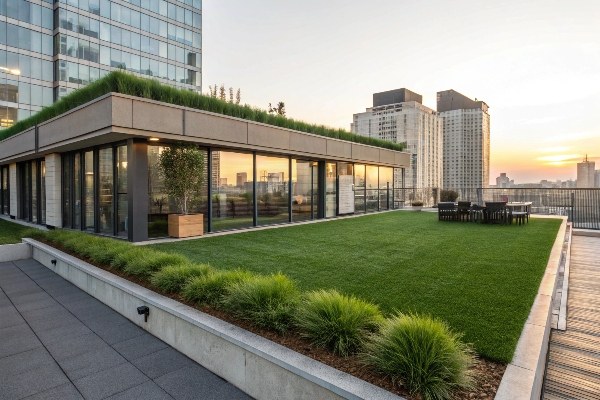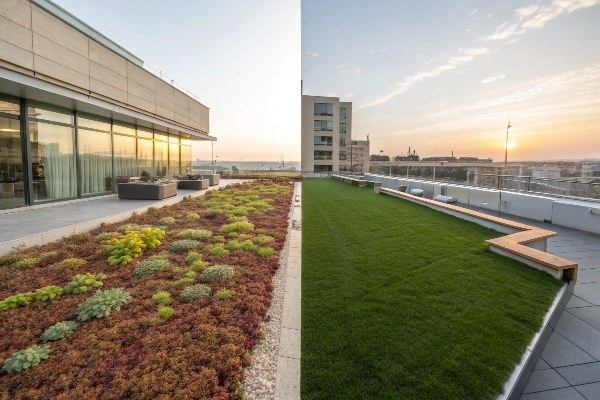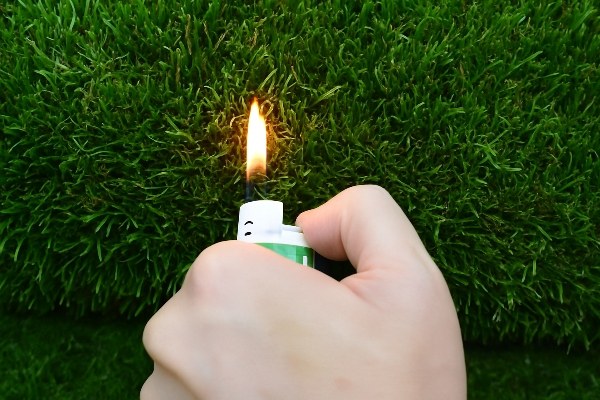Having a green roof without constant work seems impossible. Real grass is heavy, needs watering, and can cause leaks. An artificial grass roof, however, creates a vibrant, low-maintenance green space.
Yes, an artificial grass roof is often a great idea. It provides a beautiful, evergreen look without needing soil, water, or mowing. It is lightweight, durable, and a practical choice for many rooftops, from small balconies to large commercial terraces, offering beauty with minimal effort.

Using artificial grass on a roof sounds straightforward, but there is more to it than just laying it down. Getting it right involves a few important considerations to ensure it is safe, secure, and long-lasting. So, let’s explore some of the key questions you might have before starting a project like this. Understanding these details will help you make the best decision.
Artificial grass or sedum?
Are you trying to choose between a living sedum roof and artificial grass? A sedum roof needs very specific conditions to grow well and can be expensive to install and maintain. Artificial grass gives you consistent green beauty without any of the gardening work.
A sedum roof is beautiful but heavy, needing extra structural support for the soil and water. It also requires ongoing maintenance. In contrast, artificial grass is lightweight and much easier to install on most existing roofs. It needs almost no upkeep, making it a more practical choice.

When I help clients decide on a green roof, weight and maintenance are always the biggest topics. A living sedum roof is a complete ecosystem. It requires layers of drainage, waterproofing, soil, and of course, the plants themselves. All of this adds significant weight. Your roof structure must be able to support it, which can mean expensive engineering work. On the other hand, artificial grass is a simple surface covering. It’s light and doesn’t demand anything from the building’s structure. I remember a client who installed a sedum roof on a commercial building. It looked great for the first year, but a dry spell killed large patches of it, and the cost to repair it was huge. For most people, the simple, always-green look of artificial grass is a much safer investment.
Here is a simple table to compare them.
| Feature | Artificial Grass | Sedum Roof |
|---|---|---|
| Weight | Lightweight | Very Heavy |
| Maintenance | Low (occasional brushing) | High (weeding, watering) |
| Installation | Simple, on existing surface | Complex, requires many layers |
| Upfront Cost | Moderate | High to Very High |
| Year-Round Look | Always green & perfect | Changes with seasons, can die |
| Water Needs | None (except for cleaning) | Regular watering required |
How is artificial grass attached to a roof?
Do you worry about your new artificial grass roof blowing away in a storm? An installation done poorly can lead to a huge mess and wasted money. Proper installation methods will make sure your turf stays flat and secure for years.
Artificial grass is attached to a roof using a combination of strong adhesives around the edges and specialized seaming tape to join pieces. For extra security, especially in windy areas, sand infill can be added to weigh the grass down. Proper adhesion is key to a long-lasting installation.

The security of the installation is everything. You cannot just lay artificial grass on a roof and hope for the best. The process must be done carefully. First, the roof surface must be completely clean, dry, and flat. Any existing drainage systems1 on the roof must be working perfectly. Water must be able to drain away under the turf. We then use a very strong, waterproof adhesive that is made for outdoor use. I always tell my team to focus on the perimeter. The edges are where the wind can lift the turf, so we apply a thick, continuous bead of glue around the entire area. If the roof is large and requires multiple rolls of turf, the seams are joined with high-strength tape and glue to create one single, solid piece. In my experience with projects in windy regions, adding a layer of silica sand as infill is a good final step. The sand adds weight and helps hold everything down securely.
How about fire safety?
Are you concerned that putting a plastic material on your roof could be a serious fire hazard? The thought of a fire on your home or building is scary. That’s why you should only use high-quality artificial grass that has fire-retardant properties.
Reputable artificial grass is not highly flammable and is designed to be self-extinguishing. Quality products are tested and will melt instead of bursting into flames when exposed to fire. This helps prevent fire from spreading. Always ask for a fire safety certificate to meet building codes.

Fire safety is not something you can ignore, especially on a roof. This is one area where the quality of the product matters most. Cheap, low-quality artificial grass might not have any fire-retardant chemicals mixed into the plastic. This is very dangerous. High-quality artificial grass, like the products we supply at QH Grass, is different. It is manufactured to meet specific safety standards. It will not catch fire easily from something like a dropped cigarette or a spark from a barbecue. If it is exposed to a direct flame, the material is designed to melt and shrink away from the fire source, rather than helping the fire spread. When I work with buyers, I always provide the fire safety certificate. For example, in Europe, products must meet the EN 13501-1 standard. A Cfl-s1 rating is excellent. This documentation proves the product has been tested and is safe for use on buildings. Never buy turf for a roof without this proof.
Conclusion
An artificial grass roof is a smart, low-maintenance choice. Just make sure you select a quality, fire-rated product and have it installed correctly for safety and long-term performance.
-
Learn why effective drainage systems are crucial for the longevity of roof installations. ↩
_画板-1.png)
_画板-1.png)